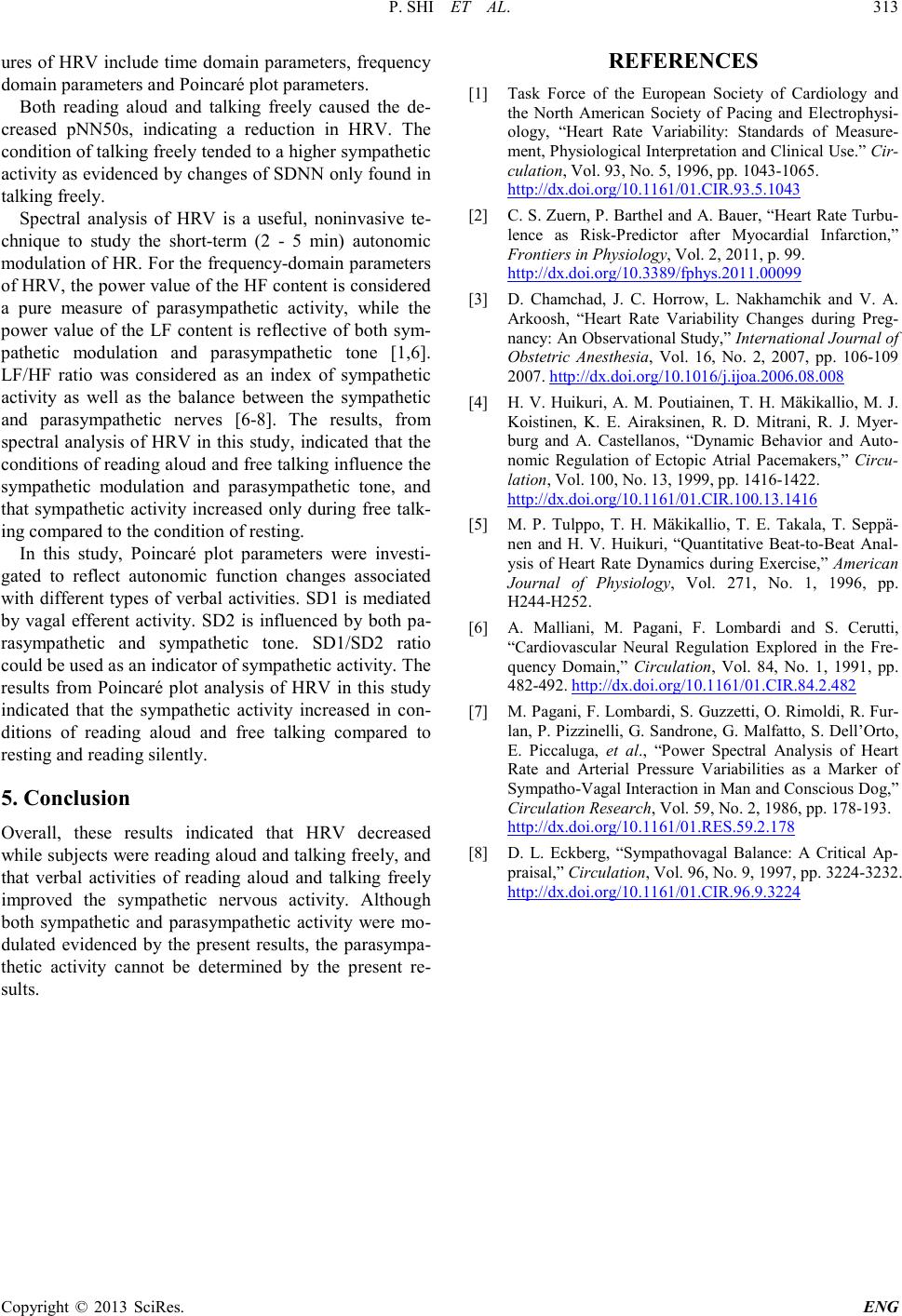
P. SHI ET AL.
Copyright © 2013 SciRes. ENG
ures of HRV include time domain parameters, frequency
domain parameters and Poincaré plot parameters.
Both reading aloud and talking freely caused the de-
creased pNN50s, indicating a reduction in HRV. The
condition of talking freely tended to a higher sympathetic
activity as evidenced by changes of SDNN only found in
talki ng fr ee l y.
Spectral analysis of HRV is a useful, noninvasive te-
chnique to study the short-term (2 - 5 min) autonomic
modulation o f HR. For the frequency-do main parameters
of HRV, the power value of the HF content is considered
a pure measure of parasympathetic activity, while the
power value of the LF content is reflective of both sym-
pathetic modulation and parasympathetic tone [1,6].
LF/HF ratio was considered as an index of sympathetic
activity as well as the balance between the sympathetic
and parasympathetic nerves [6-8]. The results, from
spectral analysis of HRV in this study, indicated that the
conditions of reading aloud and free talking influe nce th e
sympathetic modulation and parasympathetic tone, and
that sympathetic activity increased only during free talk-
ing compared to the condition of resting.
In this study, Poincaré plot parameters were investi-
gated to reflect autonomic function changes associated
with different types of verbal activities. SD1 is mediated
by vagal efferent activity. SD2 is influenced by both pa-
rasympathetic and sympathetic tone. SD1/SD2 ratio
could be used as an indicator of sympathetic activity. The
results from Poincaré plot analysis of HRV in this study
indicated that the sympathetic activity increased in con-
ditions of reading aloud and free talking compared to
resting and reading silently.
5. Conclusion
Overall, these results indicated that HRV decreased
while subjects were reading aloud and talking freely, and
that verbal activities of reading aloud and talking freely
improved the sympathetic nervous activity. Although
both sympathetic and parasympathetic activity were mo-
dulated evidenced by the present results, the parasympa-
thetic activity cannot be determined by the present re-
sults.
REFERENCES
[1] Task Force of the European Society of Cardiology and
the North American Society of Pacing and Electrophysi-
ology, “Heart Rate Variability: Standards of Measure-
ment, Physiological Interpretation and Clinical Use.” Cir-
culation, Vol. 93, No. 5, 1996, pp. 1043-1065.
http://dx.doi.org/10.1161/01.CIR.93.5.1043
[2] C. S. Zuern, P. Barthel and A. Bauer, “Heart Rat e Turbu-
lence as Risk-Predictor after Myocardial Infarction,”
Frontiers in Physiology, Vol. 2, 2011, p. 99.
http://dx.doi.org/10.3389/fphys.2011.00099
[3] D. Chamchad, J. C. Horrow, L. Nakhamchik and V. A.
Arkoosh, “Heart Rate Variability Changes during Preg-
nancy: An Observational Study,” International Journal of
Obstetric Anesthesia, Vol. 16, No. 2, 2007, pp. 106-109
2007. http://dx.doi.org/10.1016/j.ijoa.2006.08.008
[4] H. V. Huikuri, A. M. Poutiainen, T. H. Mäkikallio, M. J.
Koistinen, K. E. Airaksinen, R. D. Mitrani, R. J. Myer-
burg and A. Castellanos, “Dynamic Behavior and Auto-
nomic Regulation of Ectopic Atrial Pacemakers,” Circu-
lation, Vol. 100, No. 13, 1999, pp. 1416-1422.
http://dx.doi.org/10.1161/01.CIR.100.13.1416
[5] M. P. Tulppo, T. H. Mäkikallio, T. E. Takala, T. Seppä-
nen and H. V. Huikuri, “Quantitative Beat-to-Beat Anal-
ysis of Heart Rate Dynamics during Exercise,” American
Journal of Physiology, Vol. 271, No. 1, 1996, pp.
H244-H252.
[6] A. Malliani, M. Pagani, F. Lombardi and S. Cerutti,
“Cardiovascular Neural Regulation Explored in the Fre-
quency Domain,” Circulation, Vol. 84, No. 1, 1991, pp.
482-492. http://dx.doi.org/10.1161/01.CIR.84.2.482
[7] M. Pagani, F. Lombardi, S. Guzzetti, O. Rimoldi, R. Fur-
lan, P. P izzinelli, G. Sandron e, G. Malfatto, S. Dell ’Orto,
E. Piccaluga, et al., “Power Spectral Analysis of Heart
Rate and Arterial Pressure Variabilities as a Marker of
Sympatho-Vagal Interact io n in Man and Conscious Dog,”
Circ ulat ion Rese ar c h, Vol. 59, No. 2, 1986, pp. 178 -193.
http://dx.doi.org/10.1161/01.RES.59.2.178
[8] D. L. Eckberg, “Sympathovagal Balance: A Critical Ap-
praisal ,” Circulation, Vol. 96, No. 9, 1997, pp. 3224-3232.
http://dx.doi.org/10.1161/01.CIR.96.9.3224